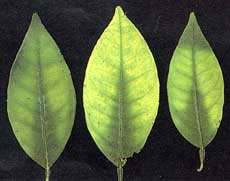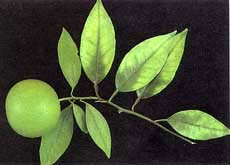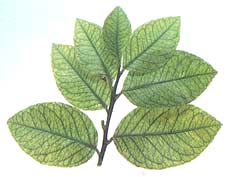
Grafting Tips:
TAMU Grafting:
Fruit Trees:
Citrus Trees:
Around the
yard:
Useful stuff:
Our Edible Landscaping:
18,000 visitors since the beginning
Visitors since 20Feb05
Magnesium deficiency in citrus
| Magnesium deficiency produces a very
distinct yellowing towards the apex of the older leaves, with a triangular
area remaining green at the leaf base. Affected leaves fall prematurely in
late summer and autumn. The defoliation can be heavy when a large crop is
being carried. If the deficiency is not corrected it weakens trees. Magnesium deficiency in orange trees (top photo) and in lemon trees (middle photo) results in a distinct yellow pattern in the older leaves. The yellowing begins near the edge and towards the apex, leaving a triangle of green at the base of the leaf . |
Magnesium deficiency affects the older leaves first—note the young leaves are showing no pattern. A heavy crop can accentuate the deficiency in late summer, leading to a heavy fall of the yellow leaves in autumn. The tree can be left severely defoliated and weakened.
|
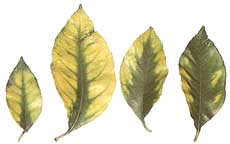 |
|
Zinc deficiency in citrusZinc deficiency, described as ‘little leaf’, ‘mottle leaf’ and ‘rosetting’, is one of the most damaging and widespread nutritional disorders of citrus. Leaf analyses conducted by NSW Agriculture have shown that over 60% of citrus orchards are low in zinc. The deficiency is most acute in alkaline soils. It also affects citrus growing on acid coastal soils. Even in its earliest stages, zinc deficiency lowers yield, reduces tree vigor and makes fruit small and poor in quality. Leaf symptoms include small, narrow leaves (little leaf) and whitish-yellow areas between the veins (mottle leaf). Leaves also crowd along short stems (rosetting), and smaller twigs die back. Symptoms are often more pronounced on the northern (sunny) side of the tree. |
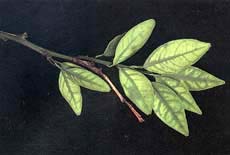 |
| Use an annual foliar spray (zinc sulphate)
on the spring flush leaves when they are about two-thirds their full size.
Severely deficient trees need two or more sprays during the season. Use a
combination spray of zinc sulfate and manganese sulfate if the tree is
also manganese-deficient. Commercial preparations of zinc and manganese are
available separately or as a combination.
|
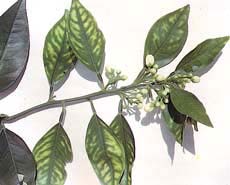 |
| Zinc deficiency produces a bright
creamy-yellow mottle. Leaves remain small and narrow (‘little leaf’) and
stems are short, giving growth a bunched appearance. Symptoms are usually
worse on the northern (sunny) side of the tree Zinc deficiency is usually most severe in the spring growth (middle photo). Note that leaves from the previous summer flush are not affected. However, when deficiency is severe and is not treated, both the summer flush leaves and the spring flush leaves are affected (bottom photo).
|
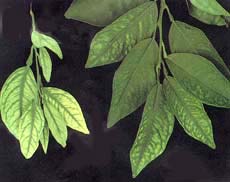 |
Iron deficiency in citrusThe plant needs iron to produce chlorophyll. Iron deficiency causes a distinct pattern in the leaf caused by a loss of chlorophyll; only the main veins stay green. Iron does not move easily within the plant, so young leaves are the worst affected, showing the symptoms, while older leaves may remain green. Iron deficiency is sometimes called ‘lime-induced chlorosis’, as it is worse in calcareous (calcium rich) soils with a high pH. This makes iron unavailable. The problem is accentuated where free lime concretions are found near the surface of the soil. A high water table (which causes a low soil-oxygen supply to the roots) or a low soil temperature can further aggravate the problem. Effective control measures include careful irrigation (avoid overwatering) and the selection of tolerant rootstocks. Do not plant Poncirus trifoliata rootstocks in problem soils, as this variety is more sensitive to iron deficiency than sweet orange, rough lemon or Troyer citrange. Cleopatra mandarin is one of the most tolerant rootstocks if there are no drainage problems. Lemons are more prone to chlorosis than oranges and grapefruit. Foliar sprays of iron sulfate or iron chelate are ineffective. If a few trees are affected, try iron chelate applied to the soil under the trees; however, this treatment is uneconomic for a large block—management is the only option here.
|
|
N -- general, uniform yellowing or fading of oldest leaves first. No pattern to it.
P -- never (?) seen in citrus, but on other plants, purplish or reddish pigment forms in the oldest leaves first. The deficiency does certainly occur in citrus; they just don't show good symptoms.
K -- Seldom seen in citrus. Oldest leaves die back, starting at the tip and along the distal margins. Looks rather like salt burn, but is uniquely on the oldest foliage.
S -- much like N, general yellowing, but always starts with the newest foliage first.
Ca -- No good leaf symptoms in citrus
Mg -- Always on the oldest leaves first. Bottom center of the leaf is green, and the end and sides are yellow or orange, making an inverted "v" or "Christmas tree" shape to the green part, as it zigzags with the veins.
Fe -- Newest leaves first. Yellowing of the leaf, but the veins remain green. No green borders around the veins; only the veins themselves remain green.
Mn -- like Iron, newest leaves first. Yellowed leaf, green veins, WITH green borders beside the veins, so the green strip is broader than that of Fe. Leaves grow to be normal size.
Zn -- like Manganese in all ways (yellow leaf, green veins with green borders, always newest leaves), but the leaf is dwarfed.
Cu -- big, wrinkly, deep blue-green leaves which look like they are made of cheap plastic. Stems bend down strangely, and develop blisters which eventually burst, bleeding gummy sap.
B -- no leaf symptoms, but the albedo (white part of the fruit peel) develops brown or grey, dying spots.
Mo -- Leaves develop bright yellow, circular spots about 1/8-1/4" across. Rare.
